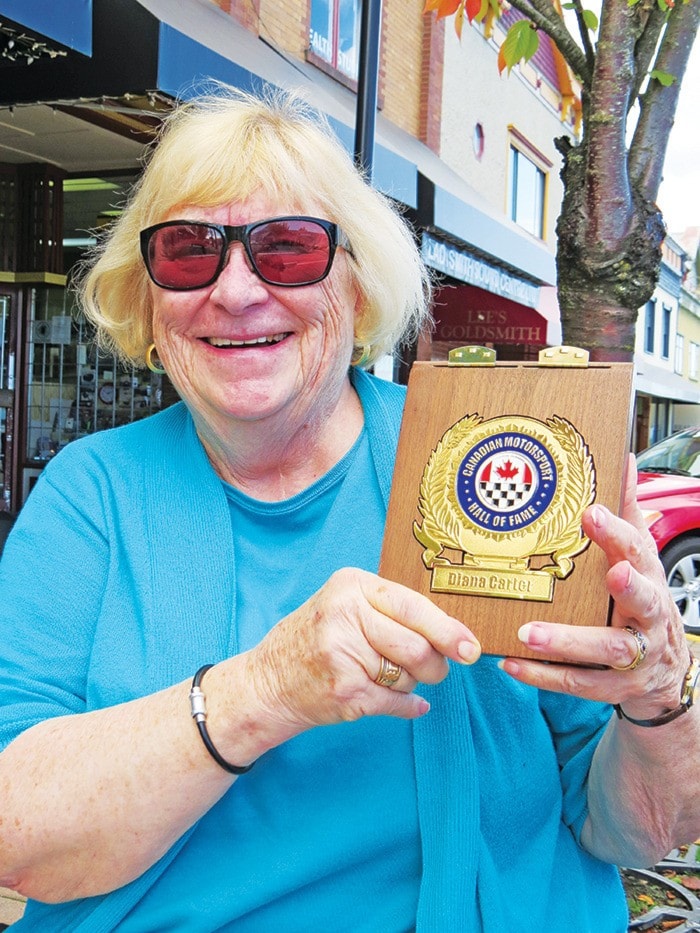When Diana Carter won her first auto race, she was featured on CBC News.
It was big news because it was the early 1960s, and she was racing against 19 men in Eugène, Que.
It certainly wouldn’t be her last win. Carter, who raced primarily at Mosport Park (now called Canadian Tire Motorsport Park), went on to win some 40 trophies over the next five years.
And now, she’s receiving a national honour for her accomplishments in racing. Carter, who lives in Cassidy, was inducted into the Canadian Motorsport Hall of Fame Sept. 27 during a ceremony at the Glen Gould Studio in downtown Toronto.
Carter became interested in racing in high school in Toronto.
“When I met my first husband, I’d sort of been interested in racing because friends of mine where interested in it since high school,” she recalled.
Carter met her first husband, Jerry Polivka, at a racetrack and through him, she began racing Volvos.
“He was racing at the time,” she said. “Eventually, he thought I had some kind of potential. There was a race in Quebec, and he said he would lend me his car. It was just me and a bunch of guys, and I won the race. The guys were really ticked off. It was kind of the first time a woman had won a race in Canada. It was on CBC News that night; it was bizarre. I just got hooked.”
Polivka was involved in publishing Canada Track & Traffic magazine, and he and his partner were in the process of building the Mosport track in Toronto. Carter was working at an ad agency at the time, and then she started working for her husband at the magazine, working as the office manager and writing columns.
Along with racing, Carter started competing in 4,000-mile rallies across Canada. She won the women’s division of the Shell 4000 Coupe des Dames three times in a row in 1963, 1964 and 1965.
“It was all back roads and tests in between,” she said. “It was just the best way to see Canada on roads people don’t usually travel. We had sections, like a closed army base, that we could go as fast as we wanted to.”
In 1966, Carter was invited to Nassau Speedway.
“It was always a big deal for a lot of drivers who were doing well at the time to go to Nassau,” she said.
Carter beat two well-known American drivers, Janet Guthrie and Denise McCluggage, in the women’s race.
“That was a huge accomplishment for me,” she said.
In 1968, Carter and Polivka went their separate ways, and Carter was offered a position in Michigan as the public relations director for the new Michigan International Speedway that was being built. The Texas International Speedway was being built at the same time, and Carter became involved in both tracks.
Four years later, Carter left the racing world. Over the coming years, she moved around in the U.S., working in advertising and accounting, at a car dealership and even owning her own art gallery.
Carter became involved in dog shows and settled in Bend, Ore., for a while.
“I had a pretty outstanding dog that was doing really well nationally,” she said.
As she neared retirement age, Carter decided to return to Canada. She moved to Cassidy 10 years ago and has worked in accounting at the Chemainus Theatre Festival for seven years.
Carter almost didn’t go to the Hall of Fame ceremony, but now she’s glad she did.
She saw a lot of old friends, and she says a lot of women came up to her and congratulated her for doing what she did when she did.
“I was extremely glad I went and I know now if I hadn’t, I would have really regretted it,” she said. “I had no idea there would be people who appreciate that. It was the ultimate ego trip that I never thought would happen.”
When Carter was racing in the 1960s, she didn’t really think about the fact she was a woman in a predominantly male world.
“I never was like a real strong feminist when I started racing,” she said. “My goal was to do whatever I should be able to do with what I was racing. My goal was to win the race or class. I had respect from the other drivers because they knew I was competitive.”
Canadian Motorsport Hall of Fame general manager Sid Priddle says Carter was honoured for her dedication and ability to drive a race car and also her administrative contributions to the sport.
“She did it on her own merit as a race driver, not just as a woman, and I think that’s very important,” he said. “She had an expression in her speech at the induction ceremony that just because you’re on a race track doesn’t mean you’re a racer. But she was a racer. She was once called Canada’s Raciest Blonde, but the reality is she was a good race car driver, not just because she was a woman.”

